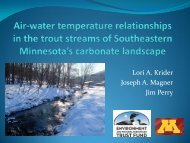Minnesota Water Resources Conference - Water Resources Center ...
Minnesota Water Resources Conference - Water Resources Center ...
Minnesota Water Resources Conference - Water Resources Center ...
Create successful ePaper yourself
Turn your PDF publications into a flip-book with our unique Google optimized e-Paper software.
Poster Session 4:45–5:45<br />
BOOK OF ABSTRACTS<br />
Tuesday, Monday, October 27 23<br />
Saint Paul’s <strong>Water</strong> Comprehensive Plan Chapter, and Saint Paul’s <strong>Water</strong> Comprehensive Plan: An<br />
Inclusive Approach to Meeting State and Local Requirements<br />
George Johnson, SEH Inc., gejohnson@sehinc.com; Larry Soderholm, Planning Administrator City of Saint Paul; Andrew<br />
Jacobson, Duke University<br />
<strong>Minnesota</strong> statute, section 473.864 directs local government units within the seven county metropolitan<br />
area to update their local Comprehensive Plans and submit them to the Metropolitan Council. This round of<br />
Comprehensive Plan updates includes, for the first time, a chapter dedicated to water resources.<br />
Saint Paul, with its history of citizen engagement, invited regulatory, nongovernmental and advocacy groups to<br />
participate in a citizen task force to create the plan. City staff and planning commissioners were the conveners<br />
and drafters. Participants include several city departments, watershed districts, neighborhood and advocacy<br />
groups, industry professionals, University of <strong>Minnesota</strong> professors, and state and federal employees.<br />
Following the broad theme of sustainability, the <strong>Water</strong> Comprehensive Plan integrates information about<br />
water supply, surface and ground water management, and sanitary sewers. The plan will set City policy until<br />
2020 to ensure safe and affordable water supply and sanitary sewer services while also protecting surface and<br />
groundwater quality.<br />
Policy Considerations in the Poplar River Turbidity TMDL Study<br />
Greg Johnson, <strong>Minnesota</strong> Control Agency, Gregory.Johnson@pca.state.mn.us; Karen Evens, <strong>Minnesota</strong> Pollution Control<br />
Agency; Pat Carey, <strong>Minnesota</strong> Pollution Control Agency; Troy Naperala, URS Corporation<br />
A TMDL study was initiated on the Poplar River along the North Shore of Lake Superior in <strong>Minnesota</strong> given<br />
significant interest by some watershed stakeholders by the MPCA. Contracts with an EPA contractor and<br />
local unit of government were developed to complete the technical and stakeholder activities for the study,<br />
respectively. Several policy and program issues and concerns arose during the EPA contractor portion<br />
of the study including the role and participation of stakeholders in the study, especially in the review of<br />
draft contractor reports; application of the turbidity standard given likely significant “natural” background<br />
contributions; consideration of a process to establish a site-specific standard; and a need to address turbidity<br />
issues along all of the North Shore. This presentation will describe the issues and work that were and are<br />
continuing to be done to address the issues and concerns.<br />
A General Method for Modeling Bacterial TMDLs Along the Texas Gulf Coast<br />
Stephanie Johnson, University of <strong>Minnesota</strong>, sljohnson@mail.utexas.edu; David Maidment, University of Texas; Mary Jo<br />
Kirisits, University of Texas<br />
With over 300 bacterial TMDLs to complete, the Texas Commission on Environmental Quality (TCEQ) has<br />
recommended the use of “simple” water quality models for initial modeling efforts. Within this paper we will<br />
discuss our attempts to expand previously used methods to develop a “simple” GIS-based modeling scheme for<br />
calculating bacterial TMDLs along the Texas Gulf Coast. Progress to date includes developing an approach to<br />
transfer the concept of load duration curves to model bacterial loading in non-riverine systems. Results also include<br />
a delineation of the watershed based on the likelihood of contributing viable bacteria to the violating waterbody.<br />
Methodologies are being developed with nationally available datasets to encourage the transfer of these concepts<br />
to other watersheds across the United States.<br />
<strong>Minnesota</strong> <strong>Water</strong> <strong>Resources</strong> <strong>Conference</strong>, October 27–28, 20078 42
















